Financial Performance Management Report: University of London
VerifiedAdded on 2023/01/04
|13
|4173
|72
Report
AI Summary
This report provides a comprehensive analysis of financial performance management, focusing on environmental accounting and the application of various planning tools. The study begins with an introduction to environmental accounting, emphasizing its role in improving ecological responsibility and integrating environmental and economic information. The main body is divided into two parts. Part 1 explores environmental costs, including prevention, appraisal, and failure costs, using Morrison's PLC as a case study. It discusses cost-benefit analysis, strategies for defining and controlling environmental expenses, and reporting methods. Part 2 delves into decision-making processes, highlighting the significance of planning tools and management accounting methods in addressing financial challenges such as sales inconsistency and rising costs. The report concludes by summarizing the key findings and emphasizing the importance of effective financial management for sustainable business practices. The report also highlights the role of Key Performance Indicators (KPIs) in enhancing financial results.

Financial Performance Management
Paraphrase This Document
Need a fresh take? Get an instant paraphrase of this document with our AI Paraphraser
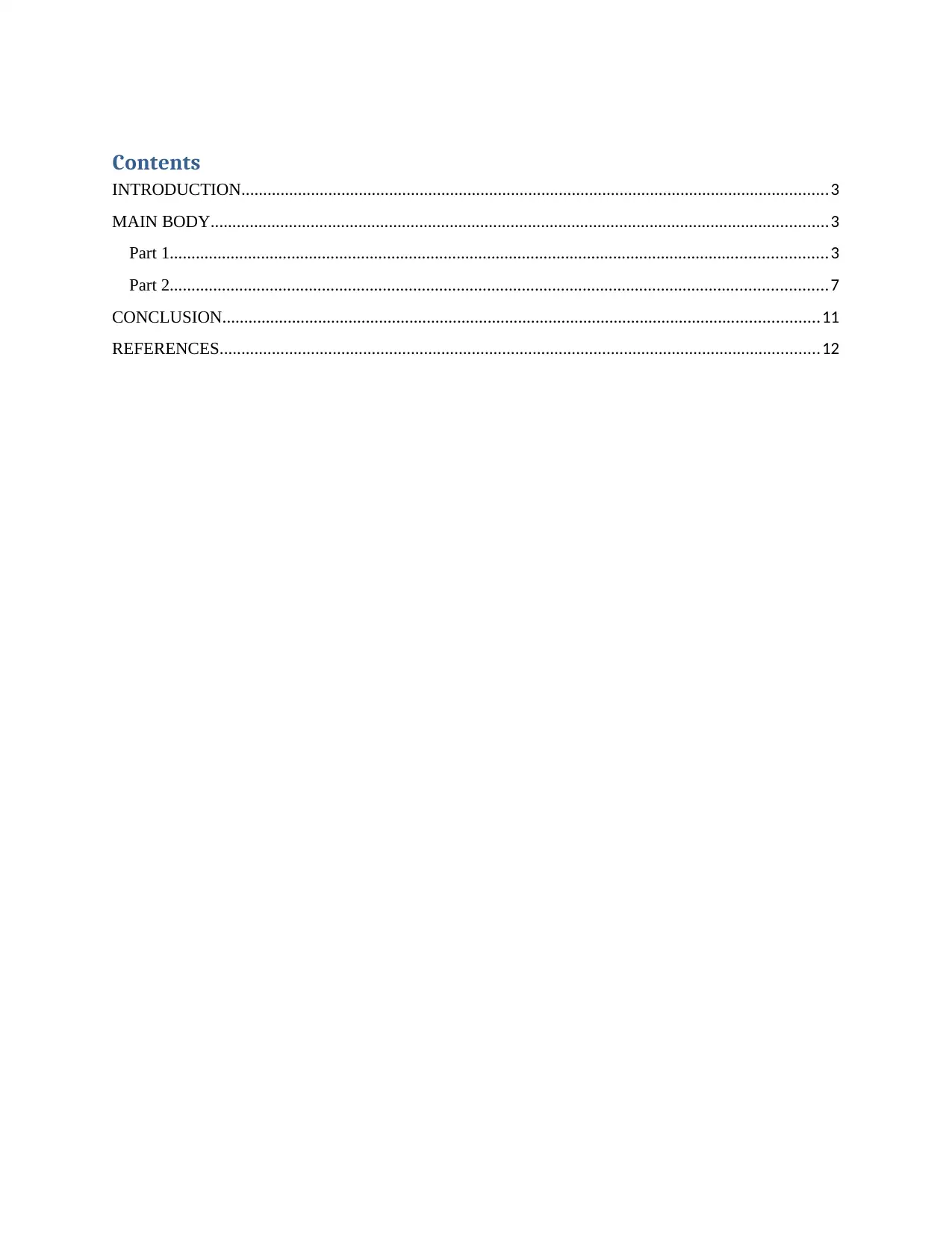
Contents
INTRODUCTION.......................................................................................................................................3
MAIN BODY..............................................................................................................................................3
Part 1.......................................................................................................................................................3
Part 2.......................................................................................................................................................7
CONCLUSION.........................................................................................................................................11
REFERENCES..........................................................................................................................................12
INTRODUCTION.......................................................................................................................................3
MAIN BODY..............................................................................................................................................3
Part 1.......................................................................................................................................................3
Part 2.......................................................................................................................................................7
CONCLUSION.........................................................................................................................................11
REFERENCES..........................................................................................................................................12
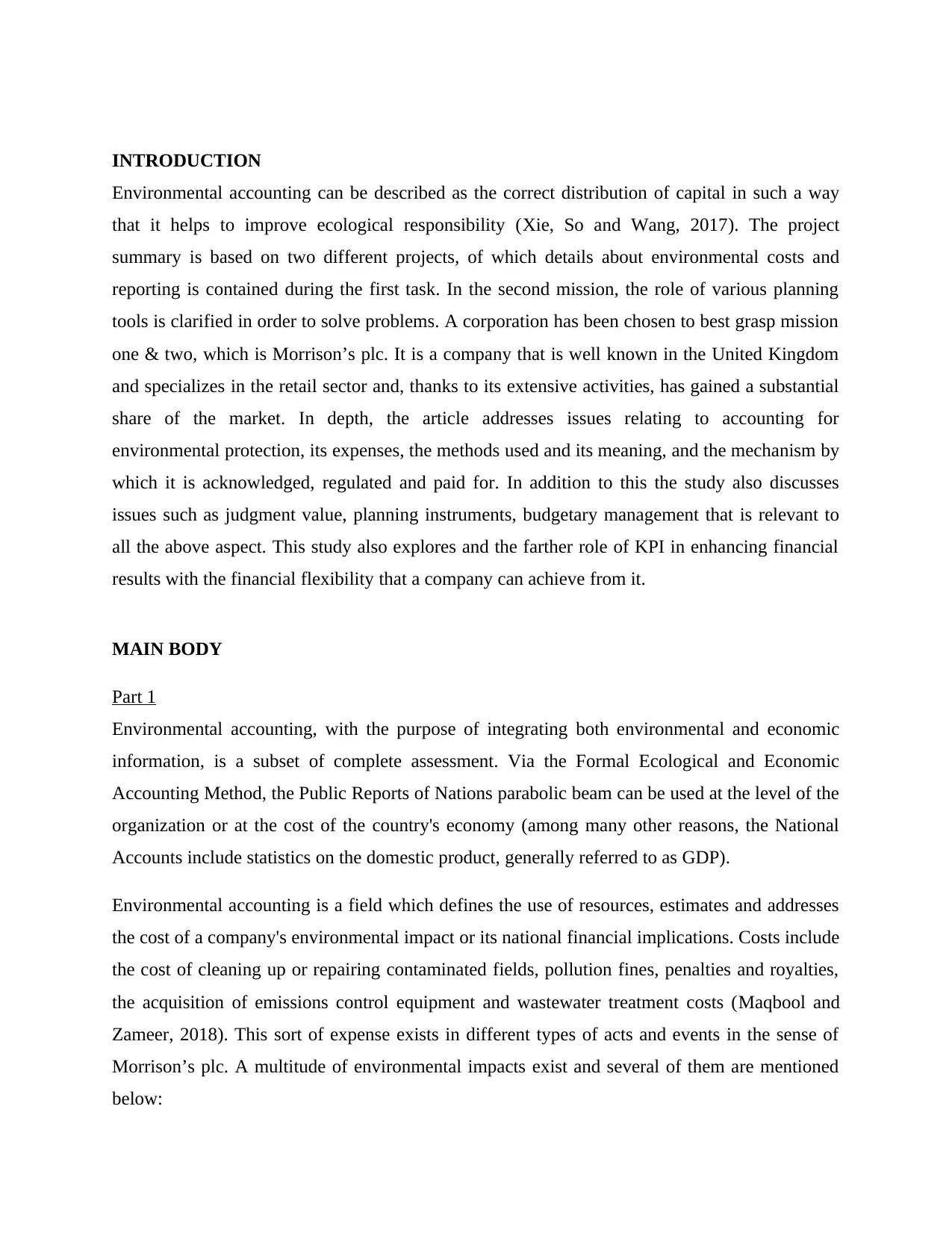
INTRODUCTION
Environmental accounting can be described as the correct distribution of capital in such a way
that it helps to improve ecological responsibility (Xie, So and Wang, 2017). The project
summary is based on two different projects, of which details about environmental costs and
reporting is contained during the first task. In the second mission, the role of various planning
tools is clarified in order to solve problems. A corporation has been chosen to best grasp mission
one & two, which is Morrison’s plc. It is a company that is well known in the United Kingdom
and specializes in the retail sector and, thanks to its extensive activities, has gained a substantial
share of the market. In depth, the article addresses issues relating to accounting for
environmental protection, its expenses, the methods used and its meaning, and the mechanism by
which it is acknowledged, regulated and paid for. In addition to this the study also discusses
issues such as judgment value, planning instruments, budgetary management that is relevant to
all the above aspect. This study also explores and the farther role of KPI in enhancing financial
results with the financial flexibility that a company can achieve from it.
MAIN BODY
Part 1
Environmental accounting, with the purpose of integrating both environmental and economic
information, is a subset of complete assessment. Via the Formal Ecological and Economic
Accounting Method, the Public Reports of Nations parabolic beam can be used at the level of the
organization or at the cost of the country's economy (among many other reasons, the National
Accounts include statistics on the domestic product, generally referred to as GDP).
Environmental accounting is a field which defines the use of resources, estimates and addresses
the cost of a company's environmental impact or its national financial implications. Costs include
the cost of cleaning up or repairing contaminated fields, pollution fines, penalties and royalties,
the acquisition of emissions control equipment and wastewater treatment costs (Maqbool and
Zameer, 2018). This sort of expense exists in different types of acts and events in the sense of
Morrison’s plc. A multitude of environmental impacts exist and several of them are mentioned
below:
Environmental accounting can be described as the correct distribution of capital in such a way
that it helps to improve ecological responsibility (Xie, So and Wang, 2017). The project
summary is based on two different projects, of which details about environmental costs and
reporting is contained during the first task. In the second mission, the role of various planning
tools is clarified in order to solve problems. A corporation has been chosen to best grasp mission
one & two, which is Morrison’s plc. It is a company that is well known in the United Kingdom
and specializes in the retail sector and, thanks to its extensive activities, has gained a substantial
share of the market. In depth, the article addresses issues relating to accounting for
environmental protection, its expenses, the methods used and its meaning, and the mechanism by
which it is acknowledged, regulated and paid for. In addition to this the study also discusses
issues such as judgment value, planning instruments, budgetary management that is relevant to
all the above aspect. This study also explores and the farther role of KPI in enhancing financial
results with the financial flexibility that a company can achieve from it.
MAIN BODY
Part 1
Environmental accounting, with the purpose of integrating both environmental and economic
information, is a subset of complete assessment. Via the Formal Ecological and Economic
Accounting Method, the Public Reports of Nations parabolic beam can be used at the level of the
organization or at the cost of the country's economy (among many other reasons, the National
Accounts include statistics on the domestic product, generally referred to as GDP).
Environmental accounting is a field which defines the use of resources, estimates and addresses
the cost of a company's environmental impact or its national financial implications. Costs include
the cost of cleaning up or repairing contaminated fields, pollution fines, penalties and royalties,
the acquisition of emissions control equipment and wastewater treatment costs (Maqbool and
Zameer, 2018). This sort of expense exists in different types of acts and events in the sense of
Morrison’s plc. A multitude of environmental impacts exist and several of them are mentioned
below:
⊘ This is a preview!⊘
Do you want full access?
Subscribe today to unlock all pages.

Trusted by 1+ million students worldwide
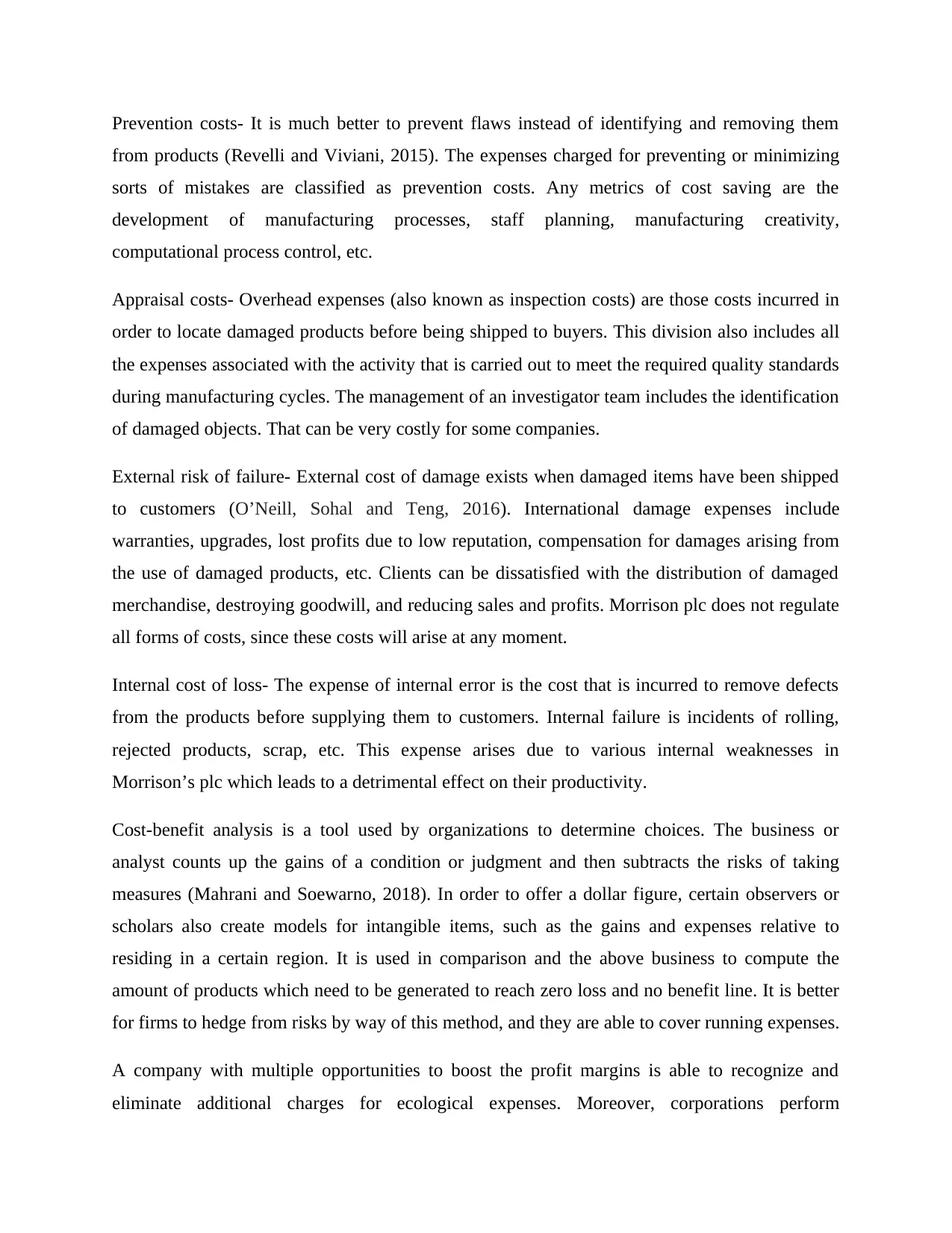
Prevention costs- It is much better to prevent flaws instead of identifying and removing them
from products (Revelli and Viviani, 2015). The expenses charged for preventing or minimizing
sorts of mistakes are classified as prevention costs. Any metrics of cost saving are the
development of manufacturing processes, staff planning, manufacturing creativity,
computational process control, etc.
Appraisal costs- Overhead expenses (also known as inspection costs) are those costs incurred in
order to locate damaged products before being shipped to buyers. This division also includes all
the expenses associated with the activity that is carried out to meet the required quality standards
during manufacturing cycles. The management of an investigator team includes the identification
of damaged objects. That can be very costly for some companies.
External risk of failure- External cost of damage exists when damaged items have been shipped
to customers (O’Neill, Sohal and Teng, 2016). International damage expenses include
warranties, upgrades, lost profits due to low reputation, compensation for damages arising from
the use of damaged products, etc. Clients can be dissatisfied with the distribution of damaged
merchandise, destroying goodwill, and reducing sales and profits. Morrison plc does not regulate
all forms of costs, since these costs will arise at any moment.
Internal cost of loss- The expense of internal error is the cost that is incurred to remove defects
from the products before supplying them to customers. Internal failure is incidents of rolling,
rejected products, scrap, etc. This expense arises due to various internal weaknesses in
Morrison’s plc which leads to a detrimental effect on their productivity.
Cost-benefit analysis is a tool used by organizations to determine choices. The business or
analyst counts up the gains of a condition or judgment and then subtracts the risks of taking
measures (Mahrani and Soewarno, 2018). In order to offer a dollar figure, certain observers or
scholars also create models for intangible items, such as the gains and expenses relative to
residing in a certain region. It is used in comparison and the above business to compute the
amount of products which need to be generated to reach zero loss and no benefit line. It is better
for firms to hedge from risks by way of this method, and they are able to cover running expenses.
A company with multiple opportunities to boost the profit margins is able to recognize and
eliminate additional charges for ecological expenses. Moreover, corporations perform
from products (Revelli and Viviani, 2015). The expenses charged for preventing or minimizing
sorts of mistakes are classified as prevention costs. Any metrics of cost saving are the
development of manufacturing processes, staff planning, manufacturing creativity,
computational process control, etc.
Appraisal costs- Overhead expenses (also known as inspection costs) are those costs incurred in
order to locate damaged products before being shipped to buyers. This division also includes all
the expenses associated with the activity that is carried out to meet the required quality standards
during manufacturing cycles. The management of an investigator team includes the identification
of damaged objects. That can be very costly for some companies.
External risk of failure- External cost of damage exists when damaged items have been shipped
to customers (O’Neill, Sohal and Teng, 2016). International damage expenses include
warranties, upgrades, lost profits due to low reputation, compensation for damages arising from
the use of damaged products, etc. Clients can be dissatisfied with the distribution of damaged
merchandise, destroying goodwill, and reducing sales and profits. Morrison plc does not regulate
all forms of costs, since these costs will arise at any moment.
Internal cost of loss- The expense of internal error is the cost that is incurred to remove defects
from the products before supplying them to customers. Internal failure is incidents of rolling,
rejected products, scrap, etc. This expense arises due to various internal weaknesses in
Morrison’s plc which leads to a detrimental effect on their productivity.
Cost-benefit analysis is a tool used by organizations to determine choices. The business or
analyst counts up the gains of a condition or judgment and then subtracts the risks of taking
measures (Mahrani and Soewarno, 2018). In order to offer a dollar figure, certain observers or
scholars also create models for intangible items, such as the gains and expenses relative to
residing in a certain region. It is used in comparison and the above business to compute the
amount of products which need to be generated to reach zero loss and no benefit line. It is better
for firms to hedge from risks by way of this method, and they are able to cover running expenses.
A company with multiple opportunities to boost the profit margins is able to recognize and
eliminate additional charges for ecological expenses. Moreover, corporations perform
Paraphrase This Document
Need a fresh take? Get an instant paraphrase of this document with our AI Paraphraser
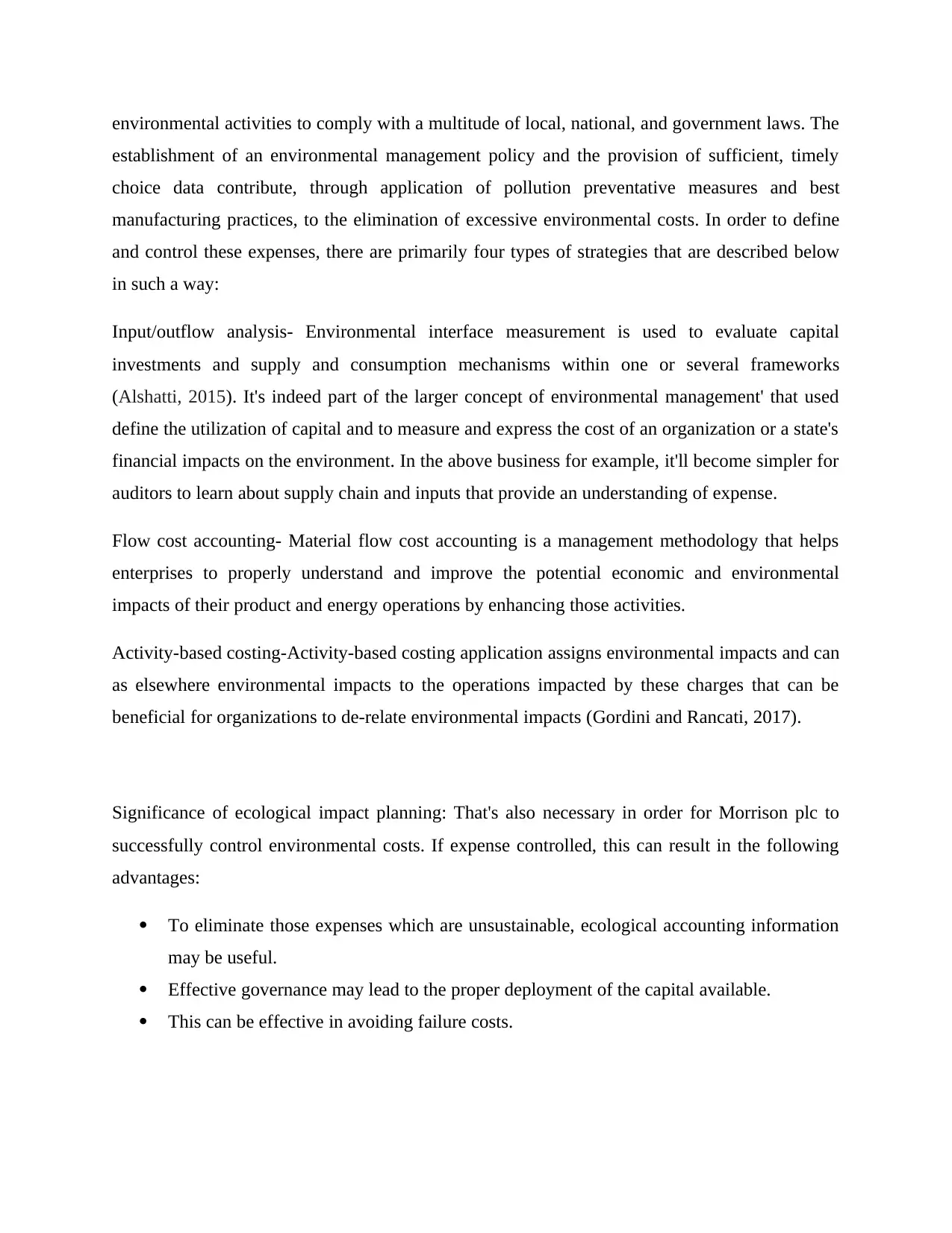
environmental activities to comply with a multitude of local, national, and government laws. The
establishment of an environmental management policy and the provision of sufficient, timely
choice data contribute, through application of pollution preventative measures and best
manufacturing practices, to the elimination of excessive environmental costs. In order to define
and control these expenses, there are primarily four types of strategies that are described below
in such a way:
Input/outflow analysis- Environmental interface measurement is used to evaluate capital
investments and supply and consumption mechanisms within one or several frameworks
(Alshatti, 2015). It's indeed part of the larger concept of environmental management' that used
define the utilization of capital and to measure and express the cost of an organization or a state's
financial impacts on the environment. In the above business for example, it'll become simpler for
auditors to learn about supply chain and inputs that provide an understanding of expense.
Flow cost accounting- Material flow cost accounting is a management methodology that helps
enterprises to properly understand and improve the potential economic and environmental
impacts of their product and energy operations by enhancing those activities.
Activity-based costing-Activity-based costing application assigns environmental impacts and can
as elsewhere environmental impacts to the operations impacted by these charges that can be
beneficial for organizations to de-relate environmental impacts (Gordini and Rancati, 2017).
Significance of ecological impact planning: That's also necessary in order for Morrison plc to
successfully control environmental costs. If expense controlled, this can result in the following
advantages:
To eliminate those expenses which are unsustainable, ecological accounting information
may be useful.
Effective governance may lead to the proper deployment of the capital available.
This can be effective in avoiding failure costs.
establishment of an environmental management policy and the provision of sufficient, timely
choice data contribute, through application of pollution preventative measures and best
manufacturing practices, to the elimination of excessive environmental costs. In order to define
and control these expenses, there are primarily four types of strategies that are described below
in such a way:
Input/outflow analysis- Environmental interface measurement is used to evaluate capital
investments and supply and consumption mechanisms within one or several frameworks
(Alshatti, 2015). It's indeed part of the larger concept of environmental management' that used
define the utilization of capital and to measure and express the cost of an organization or a state's
financial impacts on the environment. In the above business for example, it'll become simpler for
auditors to learn about supply chain and inputs that provide an understanding of expense.
Flow cost accounting- Material flow cost accounting is a management methodology that helps
enterprises to properly understand and improve the potential economic and environmental
impacts of their product and energy operations by enhancing those activities.
Activity-based costing-Activity-based costing application assigns environmental impacts and can
as elsewhere environmental impacts to the operations impacted by these charges that can be
beneficial for organizations to de-relate environmental impacts (Gordini and Rancati, 2017).
Significance of ecological impact planning: That's also necessary in order for Morrison plc to
successfully control environmental costs. If expense controlled, this can result in the following
advantages:
To eliminate those expenses which are unsustainable, ecological accounting information
may be useful.
Effective governance may lead to the proper deployment of the capital available.
This can be effective in avoiding failure costs.
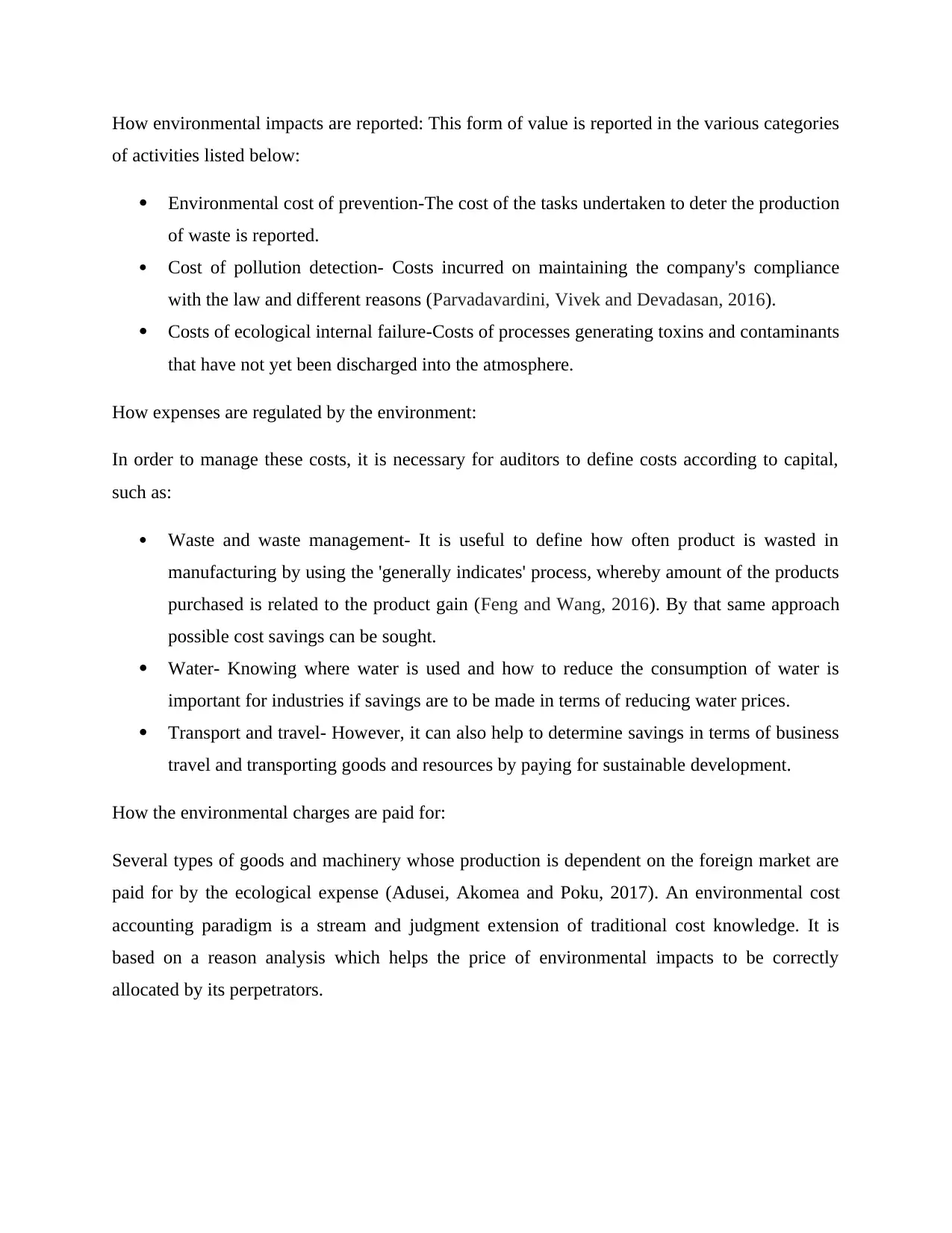
How environmental impacts are reported: This form of value is reported in the various categories
of activities listed below:
Environmental cost of prevention-The cost of the tasks undertaken to deter the production
of waste is reported.
Cost of pollution detection- Costs incurred on maintaining the company's compliance
with the law and different reasons (Parvadavardini, Vivek and Devadasan, 2016).
Costs of ecological internal failure-Costs of processes generating toxins and contaminants
that have not yet been discharged into the atmosphere.
How expenses are regulated by the environment:
In order to manage these costs, it is necessary for auditors to define costs according to capital,
such as:
Waste and waste management- It is useful to define how often product is wasted in
manufacturing by using the 'generally indicates' process, whereby amount of the products
purchased is related to the product gain (Feng and Wang, 2016). By that same approach
possible cost savings can be sought.
Water- Knowing where water is used and how to reduce the consumption of water is
important for industries if savings are to be made in terms of reducing water prices.
Transport and travel- However, it can also help to determine savings in terms of business
travel and transporting goods and resources by paying for sustainable development.
How the environmental charges are paid for:
Several types of goods and machinery whose production is dependent on the foreign market are
paid for by the ecological expense (Adusei, Akomea and Poku, 2017). An environmental cost
accounting paradigm is a stream and judgment extension of traditional cost knowledge. It is
based on a reason analysis which helps the price of environmental impacts to be correctly
allocated by its perpetrators.
of activities listed below:
Environmental cost of prevention-The cost of the tasks undertaken to deter the production
of waste is reported.
Cost of pollution detection- Costs incurred on maintaining the company's compliance
with the law and different reasons (Parvadavardini, Vivek and Devadasan, 2016).
Costs of ecological internal failure-Costs of processes generating toxins and contaminants
that have not yet been discharged into the atmosphere.
How expenses are regulated by the environment:
In order to manage these costs, it is necessary for auditors to define costs according to capital,
such as:
Waste and waste management- It is useful to define how often product is wasted in
manufacturing by using the 'generally indicates' process, whereby amount of the products
purchased is related to the product gain (Feng and Wang, 2016). By that same approach
possible cost savings can be sought.
Water- Knowing where water is used and how to reduce the consumption of water is
important for industries if savings are to be made in terms of reducing water prices.
Transport and travel- However, it can also help to determine savings in terms of business
travel and transporting goods and resources by paying for sustainable development.
How the environmental charges are paid for:
Several types of goods and machinery whose production is dependent on the foreign market are
paid for by the ecological expense (Adusei, Akomea and Poku, 2017). An environmental cost
accounting paradigm is a stream and judgment extension of traditional cost knowledge. It is
based on a reason analysis which helps the price of environmental impacts to be correctly
allocated by its perpetrators.
⊘ This is a preview!⊘
Do you want full access?
Subscribe today to unlock all pages.

Trusted by 1+ million students worldwide
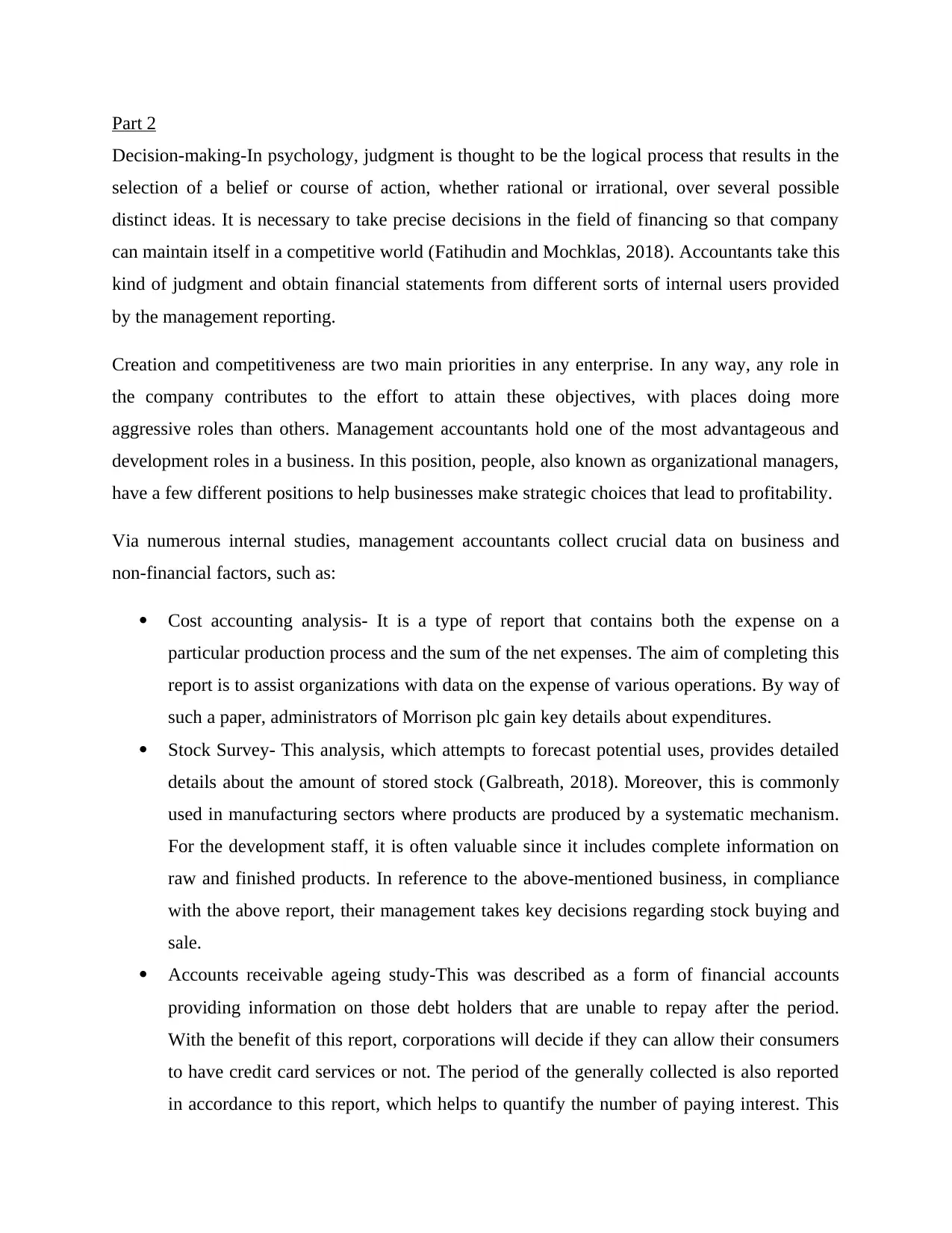
Part 2
Decision-making-In psychology, judgment is thought to be the logical process that results in the
selection of a belief or course of action, whether rational or irrational, over several possible
distinct ideas. It is necessary to take precise decisions in the field of financing so that company
can maintain itself in a competitive world (Fatihudin and Mochklas, 2018). Accountants take this
kind of judgment and obtain financial statements from different sorts of internal users provided
by the management reporting.
Creation and competitiveness are two main priorities in any enterprise. In any way, any role in
the company contributes to the effort to attain these objectives, with places doing more
aggressive roles than others. Management accountants hold one of the most advantageous and
development roles in a business. In this position, people, also known as organizational managers,
have a few different positions to help businesses make strategic choices that lead to profitability.
Via numerous internal studies, management accountants collect crucial data on business and
non-financial factors, such as:
Cost accounting analysis- It is a type of report that contains both the expense on a
particular production process and the sum of the net expenses. The aim of completing this
report is to assist organizations with data on the expense of various operations. By way of
such a paper, administrators of Morrison plc gain key details about expenditures.
Stock Survey- This analysis, which attempts to forecast potential uses, provides detailed
details about the amount of stored stock (Galbreath, 2018). Moreover, this is commonly
used in manufacturing sectors where products are produced by a systematic mechanism.
For the development staff, it is often valuable since it includes complete information on
raw and finished products. In reference to the above-mentioned business, in compliance
with the above report, their management takes key decisions regarding stock buying and
sale.
Accounts receivable ageing study-This was described as a form of financial accounts
providing information on those debt holders that are unable to repay after the period.
With the benefit of this report, corporations will decide if they can allow their consumers
to have credit card services or not. The period of the generally collected is also reported
in accordance to this report, which helps to quantify the number of paying interest. This
Decision-making-In psychology, judgment is thought to be the logical process that results in the
selection of a belief or course of action, whether rational or irrational, over several possible
distinct ideas. It is necessary to take precise decisions in the field of financing so that company
can maintain itself in a competitive world (Fatihudin and Mochklas, 2018). Accountants take this
kind of judgment and obtain financial statements from different sorts of internal users provided
by the management reporting.
Creation and competitiveness are two main priorities in any enterprise. In any way, any role in
the company contributes to the effort to attain these objectives, with places doing more
aggressive roles than others. Management accountants hold one of the most advantageous and
development roles in a business. In this position, people, also known as organizational managers,
have a few different positions to help businesses make strategic choices that lead to profitability.
Via numerous internal studies, management accountants collect crucial data on business and
non-financial factors, such as:
Cost accounting analysis- It is a type of report that contains both the expense on a
particular production process and the sum of the net expenses. The aim of completing this
report is to assist organizations with data on the expense of various operations. By way of
such a paper, administrators of Morrison plc gain key details about expenditures.
Stock Survey- This analysis, which attempts to forecast potential uses, provides detailed
details about the amount of stored stock (Galbreath, 2018). Moreover, this is commonly
used in manufacturing sectors where products are produced by a systematic mechanism.
For the development staff, it is often valuable since it includes complete information on
raw and finished products. In reference to the above-mentioned business, in compliance
with the above report, their management takes key decisions regarding stock buying and
sale.
Accounts receivable ageing study-This was described as a form of financial accounts
providing information on those debt holders that are unable to repay after the period.
With the benefit of this report, corporations will decide if they can allow their consumers
to have credit card services or not. The period of the generally collected is also reported
in accordance to this report, which helps to quantify the number of paying interest. This
Paraphrase This Document
Need a fresh take? Get an instant paraphrase of this document with our AI Paraphraser
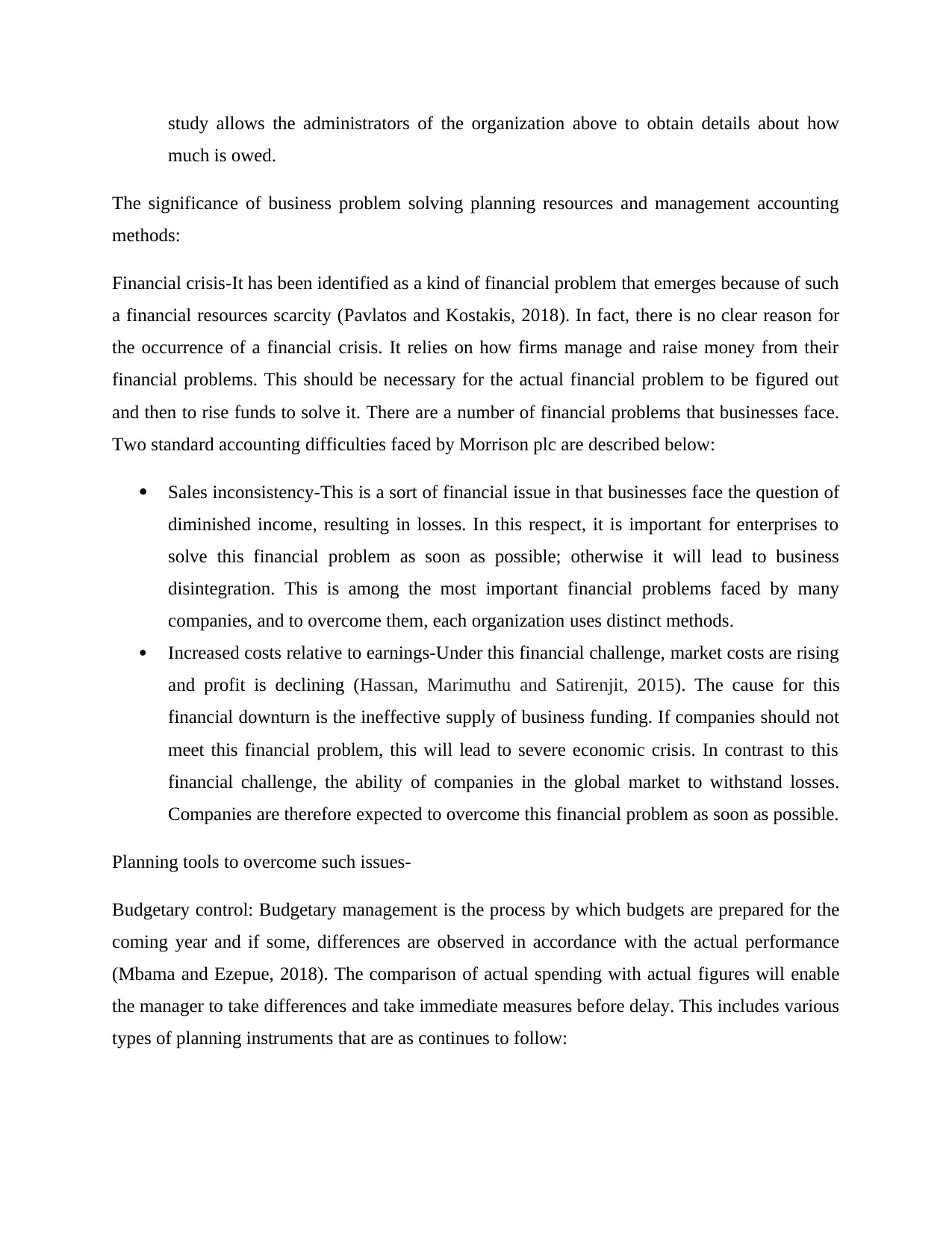
study allows the administrators of the organization above to obtain details about how
much is owed.
The significance of business problem solving planning resources and management accounting
methods:
Financial crisis-It has been identified as a kind of financial problem that emerges because of such
a financial resources scarcity (Pavlatos and Kostakis, 2018). In fact, there is no clear reason for
the occurrence of a financial crisis. It relies on how firms manage and raise money from their
financial problems. This should be necessary for the actual financial problem to be figured out
and then to rise funds to solve it. There are a number of financial problems that businesses face.
Two standard accounting difficulties faced by Morrison plc are described below:
Sales inconsistency-This is a sort of financial issue in that businesses face the question of
diminished income, resulting in losses. In this respect, it is important for enterprises to
solve this financial problem as soon as possible; otherwise it will lead to business
disintegration. This is among the most important financial problems faced by many
companies, and to overcome them, each organization uses distinct methods.
Increased costs relative to earnings-Under this financial challenge, market costs are rising
and profit is declining (Hassan, Marimuthu and Satirenjit, 2015). The cause for this
financial downturn is the ineffective supply of business funding. If companies should not
meet this financial problem, this will lead to severe economic crisis. In contrast to this
financial challenge, the ability of companies in the global market to withstand losses.
Companies are therefore expected to overcome this financial problem as soon as possible.
Planning tools to overcome such issues-
Budgetary control: Budgetary management is the process by which budgets are prepared for the
coming year and if some, differences are observed in accordance with the actual performance
(Mbama and Ezepue, 2018). The comparison of actual spending with actual figures will enable
the manager to take differences and take immediate measures before delay. This includes various
types of planning instruments that are as continues to follow:
much is owed.
The significance of business problem solving planning resources and management accounting
methods:
Financial crisis-It has been identified as a kind of financial problem that emerges because of such
a financial resources scarcity (Pavlatos and Kostakis, 2018). In fact, there is no clear reason for
the occurrence of a financial crisis. It relies on how firms manage and raise money from their
financial problems. This should be necessary for the actual financial problem to be figured out
and then to rise funds to solve it. There are a number of financial problems that businesses face.
Two standard accounting difficulties faced by Morrison plc are described below:
Sales inconsistency-This is a sort of financial issue in that businesses face the question of
diminished income, resulting in losses. In this respect, it is important for enterprises to
solve this financial problem as soon as possible; otherwise it will lead to business
disintegration. This is among the most important financial problems faced by many
companies, and to overcome them, each organization uses distinct methods.
Increased costs relative to earnings-Under this financial challenge, market costs are rising
and profit is declining (Hassan, Marimuthu and Satirenjit, 2015). The cause for this
financial downturn is the ineffective supply of business funding. If companies should not
meet this financial problem, this will lead to severe economic crisis. In contrast to this
financial challenge, the ability of companies in the global market to withstand losses.
Companies are therefore expected to overcome this financial problem as soon as possible.
Planning tools to overcome such issues-
Budgetary control: Budgetary management is the process by which budgets are prepared for the
coming year and if some, differences are observed in accordance with the actual performance
(Mbama and Ezepue, 2018). The comparison of actual spending with actual figures will enable
the manager to take differences and take immediate measures before delay. This includes various
types of planning instruments that are as continues to follow:
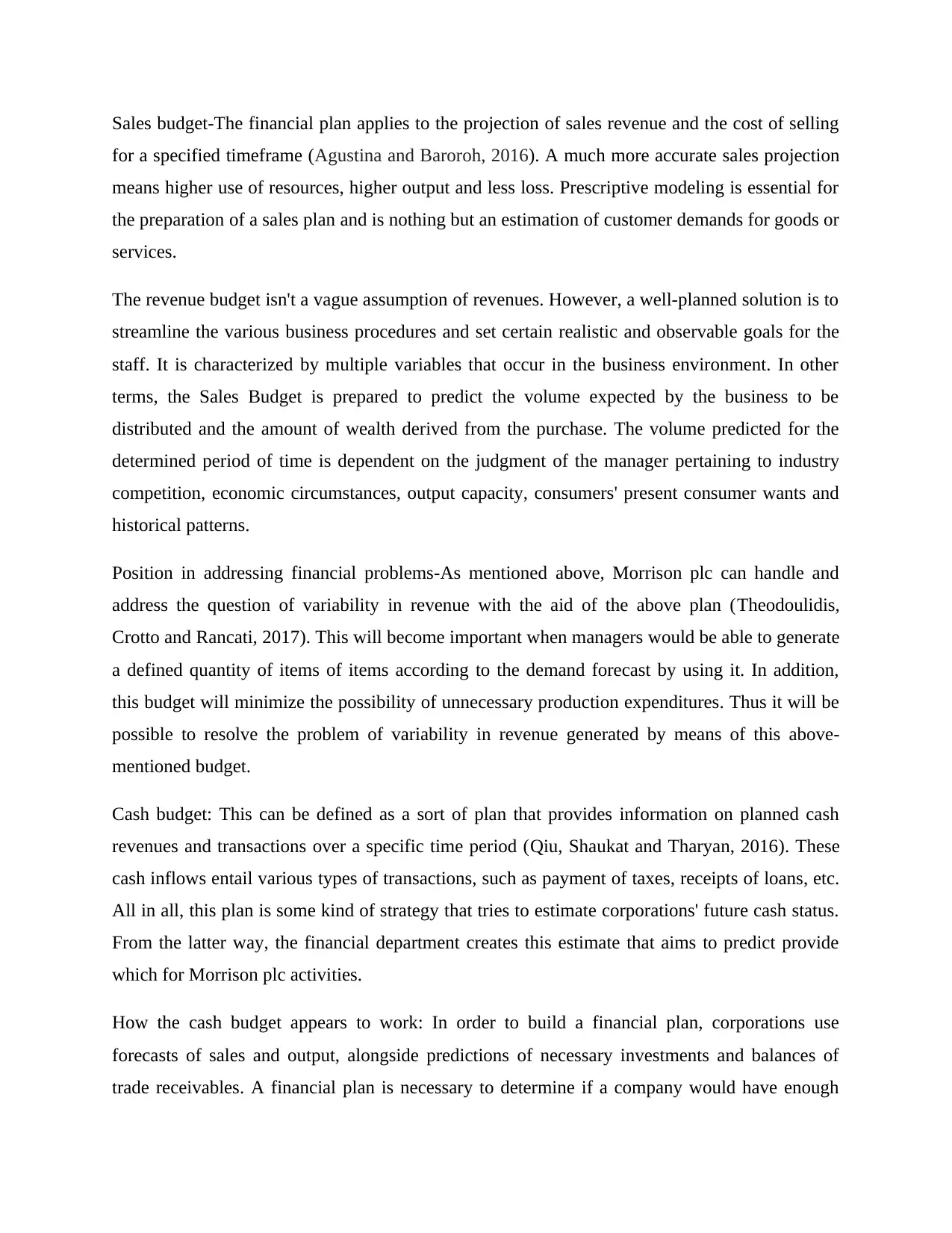
Sales budget-The financial plan applies to the projection of sales revenue and the cost of selling
for a specified timeframe (Agustina and Baroroh, 2016). A much more accurate sales projection
means higher use of resources, higher output and less loss. Prescriptive modeling is essential for
the preparation of a sales plan and is nothing but an estimation of customer demands for goods or
services.
The revenue budget isn't a vague assumption of revenues. However, a well-planned solution is to
streamline the various business procedures and set certain realistic and observable goals for the
staff. It is characterized by multiple variables that occur in the business environment. In other
terms, the Sales Budget is prepared to predict the volume expected by the business to be
distributed and the amount of wealth derived from the purchase. The volume predicted for the
determined period of time is dependent on the judgment of the manager pertaining to industry
competition, economic circumstances, output capacity, consumers' present consumer wants and
historical patterns.
Position in addressing financial problems-As mentioned above, Morrison plc can handle and
address the question of variability in revenue with the aid of the above plan (Theodoulidis,
Crotto and Rancati, 2017). This will become important when managers would be able to generate
a defined quantity of items of items according to the demand forecast by using it. In addition,
this budget will minimize the possibility of unnecessary production expenditures. Thus it will be
possible to resolve the problem of variability in revenue generated by means of this above-
mentioned budget.
Cash budget: This can be defined as a sort of plan that provides information on planned cash
revenues and transactions over a specific time period (Qiu, Shaukat and Tharyan, 2016). These
cash inflows entail various types of transactions, such as payment of taxes, receipts of loans, etc.
All in all, this plan is some kind of strategy that tries to estimate corporations' future cash status.
From the latter way, the financial department creates this estimate that aims to predict provide
which for Morrison plc activities.
How the cash budget appears to work: In order to build a financial plan, corporations use
forecasts of sales and output, alongside predictions of necessary investments and balances of
trade receivables. A financial plan is necessary to determine if a company would have enough
for a specified timeframe (Agustina and Baroroh, 2016). A much more accurate sales projection
means higher use of resources, higher output and less loss. Prescriptive modeling is essential for
the preparation of a sales plan and is nothing but an estimation of customer demands for goods or
services.
The revenue budget isn't a vague assumption of revenues. However, a well-planned solution is to
streamline the various business procedures and set certain realistic and observable goals for the
staff. It is characterized by multiple variables that occur in the business environment. In other
terms, the Sales Budget is prepared to predict the volume expected by the business to be
distributed and the amount of wealth derived from the purchase. The volume predicted for the
determined period of time is dependent on the judgment of the manager pertaining to industry
competition, economic circumstances, output capacity, consumers' present consumer wants and
historical patterns.
Position in addressing financial problems-As mentioned above, Morrison plc can handle and
address the question of variability in revenue with the aid of the above plan (Theodoulidis,
Crotto and Rancati, 2017). This will become important when managers would be able to generate
a defined quantity of items of items according to the demand forecast by using it. In addition,
this budget will minimize the possibility of unnecessary production expenditures. Thus it will be
possible to resolve the problem of variability in revenue generated by means of this above-
mentioned budget.
Cash budget: This can be defined as a sort of plan that provides information on planned cash
revenues and transactions over a specific time period (Qiu, Shaukat and Tharyan, 2016). These
cash inflows entail various types of transactions, such as payment of taxes, receipts of loans, etc.
All in all, this plan is some kind of strategy that tries to estimate corporations' future cash status.
From the latter way, the financial department creates this estimate that aims to predict provide
which for Morrison plc activities.
How the cash budget appears to work: In order to build a financial plan, corporations use
forecasts of sales and output, alongside predictions of necessary investments and balances of
trade receivables. A financial plan is necessary to determine if a company would have enough
⊘ This is a preview!⊘
Do you want full access?
Subscribe today to unlock all pages.

Trusted by 1+ million students worldwide
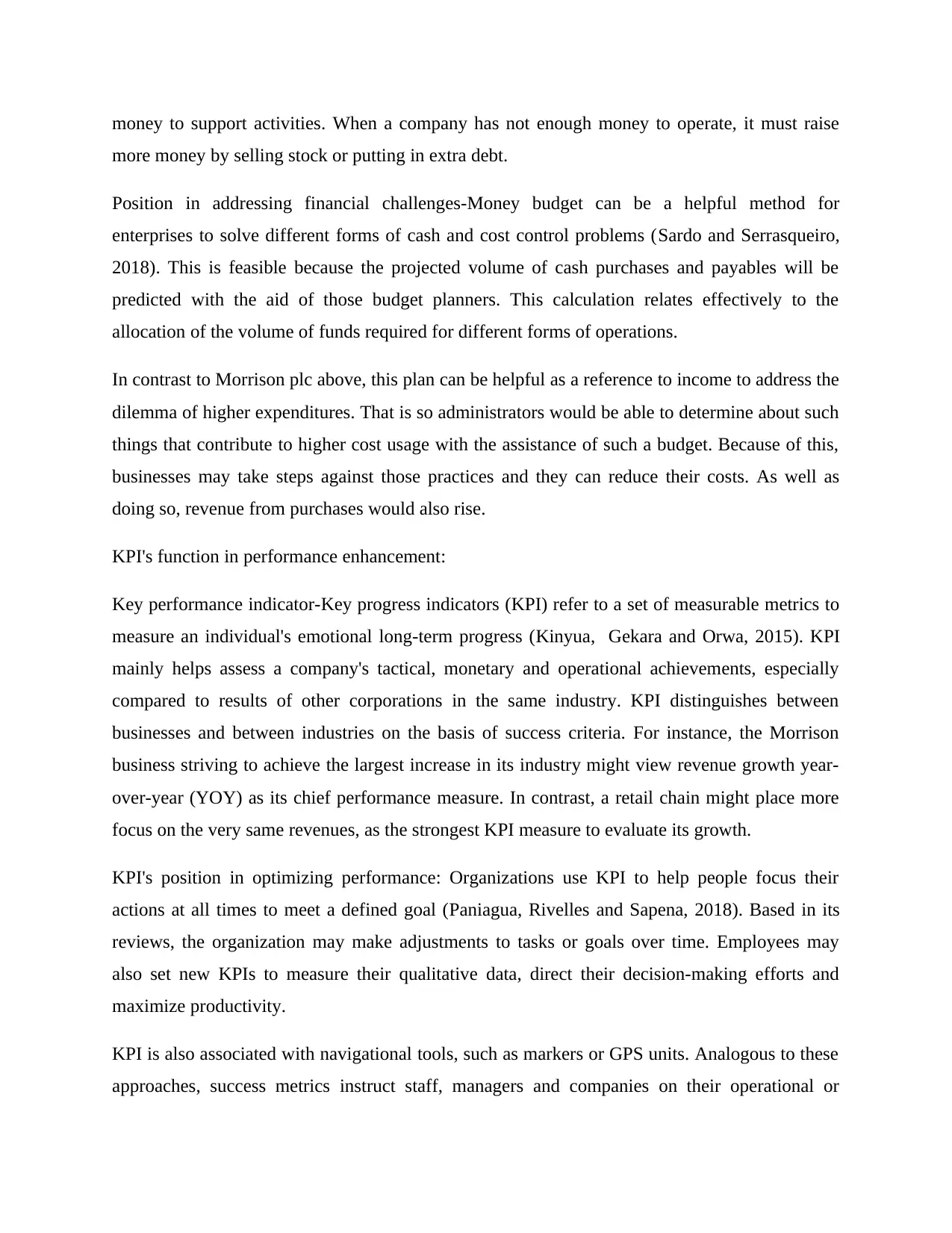
money to support activities. When a company has not enough money to operate, it must raise
more money by selling stock or putting in extra debt.
Position in addressing financial challenges-Money budget can be a helpful method for
enterprises to solve different forms of cash and cost control problems (Sardo and Serrasqueiro,
2018). This is feasible because the projected volume of cash purchases and payables will be
predicted with the aid of those budget planners. This calculation relates effectively to the
allocation of the volume of funds required for different forms of operations.
In contrast to Morrison plc above, this plan can be helpful as a reference to income to address the
dilemma of higher expenditures. That is so administrators would be able to determine about such
things that contribute to higher cost usage with the assistance of such a budget. Because of this,
businesses may take steps against those practices and they can reduce their costs. As well as
doing so, revenue from purchases would also rise.
KPI's function in performance enhancement:
Key performance indicator-Key progress indicators (KPI) refer to a set of measurable metrics to
measure an individual's emotional long-term progress (Kinyua, Gekara and Orwa, 2015). KPI
mainly helps assess a company's tactical, monetary and operational achievements, especially
compared to results of other corporations in the same industry. KPI distinguishes between
businesses and between industries on the basis of success criteria. For instance, the Morrison
business striving to achieve the largest increase in its industry might view revenue growth year-
over-year (YOY) as its chief performance measure. In contrast, a retail chain might place more
focus on the very same revenues, as the strongest KPI measure to evaluate its growth.
KPI's position in optimizing performance: Organizations use KPI to help people focus their
actions at all times to meet a defined goal (Paniagua, Rivelles and Sapena, 2018). Based in its
reviews, the organization may make adjustments to tasks or goals over time. Employees may
also set new KPIs to measure their qualitative data, direct their decision-making efforts and
maximize productivity.
KPI is also associated with navigational tools, such as markers or GPS units. Analogous to these
approaches, success metrics instruct staff, managers and companies on their operational or
more money by selling stock or putting in extra debt.
Position in addressing financial challenges-Money budget can be a helpful method for
enterprises to solve different forms of cash and cost control problems (Sardo and Serrasqueiro,
2018). This is feasible because the projected volume of cash purchases and payables will be
predicted with the aid of those budget planners. This calculation relates effectively to the
allocation of the volume of funds required for different forms of operations.
In contrast to Morrison plc above, this plan can be helpful as a reference to income to address the
dilemma of higher expenditures. That is so administrators would be able to determine about such
things that contribute to higher cost usage with the assistance of such a budget. Because of this,
businesses may take steps against those practices and they can reduce their costs. As well as
doing so, revenue from purchases would also rise.
KPI's function in performance enhancement:
Key performance indicator-Key progress indicators (KPI) refer to a set of measurable metrics to
measure an individual's emotional long-term progress (Kinyua, Gekara and Orwa, 2015). KPI
mainly helps assess a company's tactical, monetary and operational achievements, especially
compared to results of other corporations in the same industry. KPI distinguishes between
businesses and between industries on the basis of success criteria. For instance, the Morrison
business striving to achieve the largest increase in its industry might view revenue growth year-
over-year (YOY) as its chief performance measure. In contrast, a retail chain might place more
focus on the very same revenues, as the strongest KPI measure to evaluate its growth.
KPI's position in optimizing performance: Organizations use KPI to help people focus their
actions at all times to meet a defined goal (Paniagua, Rivelles and Sapena, 2018). Based in its
reviews, the organization may make adjustments to tasks or goals over time. Employees may
also set new KPIs to measure their qualitative data, direct their decision-making efforts and
maximize productivity.
KPI is also associated with navigational tools, such as markers or GPS units. Analogous to these
approaches, success metrics instruct staff, managers and companies on their operational or
Paraphrase This Document
Need a fresh take? Get an instant paraphrase of this document with our AI Paraphraser
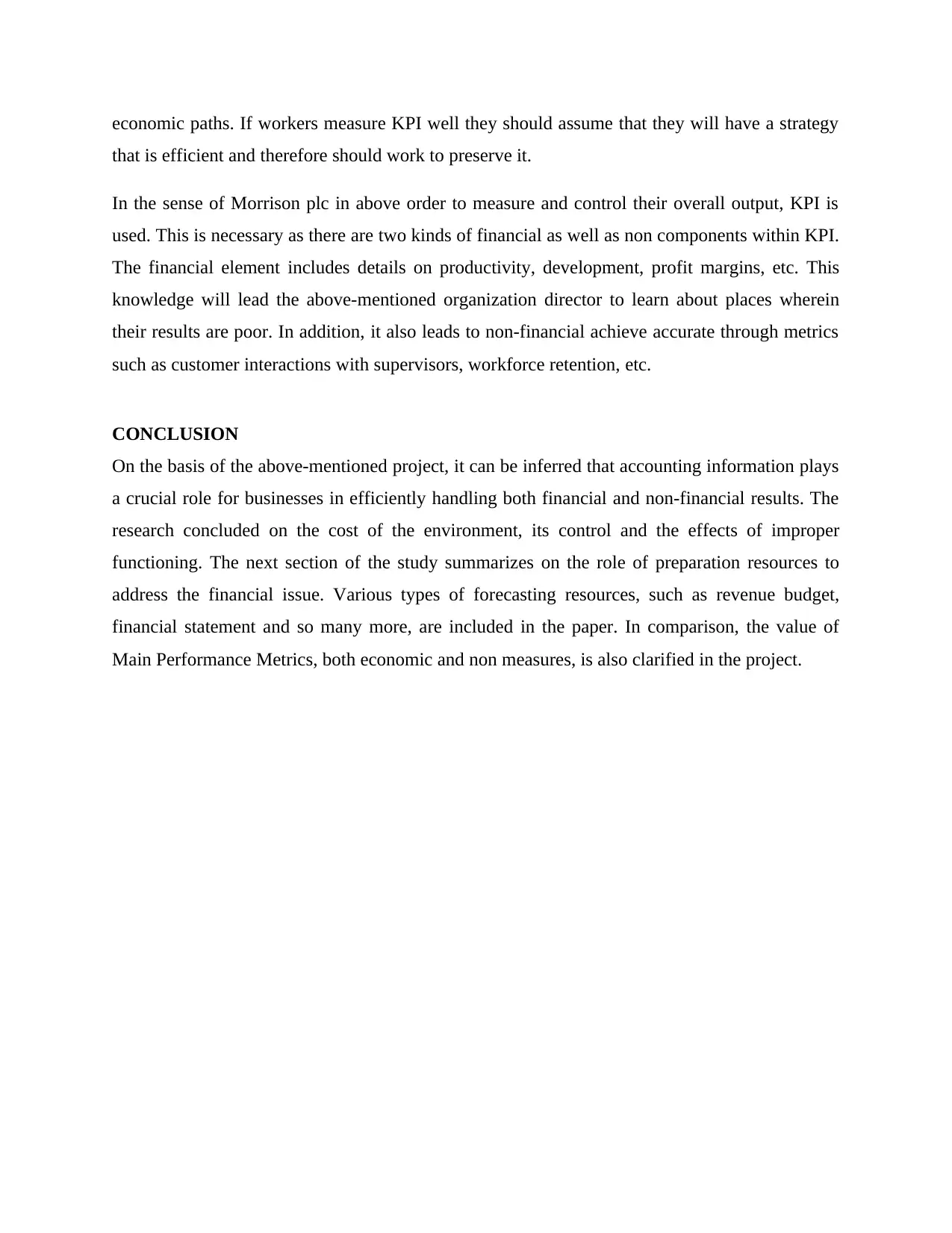
economic paths. If workers measure KPI well they should assume that they will have a strategy
that is efficient and therefore should work to preserve it.
In the sense of Morrison plc in above order to measure and control their overall output, KPI is
used. This is necessary as there are two kinds of financial as well as non components within KPI.
The financial element includes details on productivity, development, profit margins, etc. This
knowledge will lead the above-mentioned organization director to learn about places wherein
their results are poor. In addition, it also leads to non-financial achieve accurate through metrics
such as customer interactions with supervisors, workforce retention, etc.
CONCLUSION
On the basis of the above-mentioned project, it can be inferred that accounting information plays
a crucial role for businesses in efficiently handling both financial and non-financial results. The
research concluded on the cost of the environment, its control and the effects of improper
functioning. The next section of the study summarizes on the role of preparation resources to
address the financial issue. Various types of forecasting resources, such as revenue budget,
financial statement and so many more, are included in the paper. In comparison, the value of
Main Performance Metrics, both economic and non measures, is also clarified in the project.
that is efficient and therefore should work to preserve it.
In the sense of Morrison plc in above order to measure and control their overall output, KPI is
used. This is necessary as there are two kinds of financial as well as non components within KPI.
The financial element includes details on productivity, development, profit margins, etc. This
knowledge will lead the above-mentioned organization director to learn about places wherein
their results are poor. In addition, it also leads to non-financial achieve accurate through metrics
such as customer interactions with supervisors, workforce retention, etc.
CONCLUSION
On the basis of the above-mentioned project, it can be inferred that accounting information plays
a crucial role for businesses in efficiently handling both financial and non-financial results. The
research concluded on the cost of the environment, its control and the effects of improper
functioning. The next section of the study summarizes on the role of preparation resources to
address the financial issue. Various types of forecasting resources, such as revenue budget,
financial statement and so many more, are included in the paper. In comparison, the value of
Main Performance Metrics, both economic and non measures, is also clarified in the project.
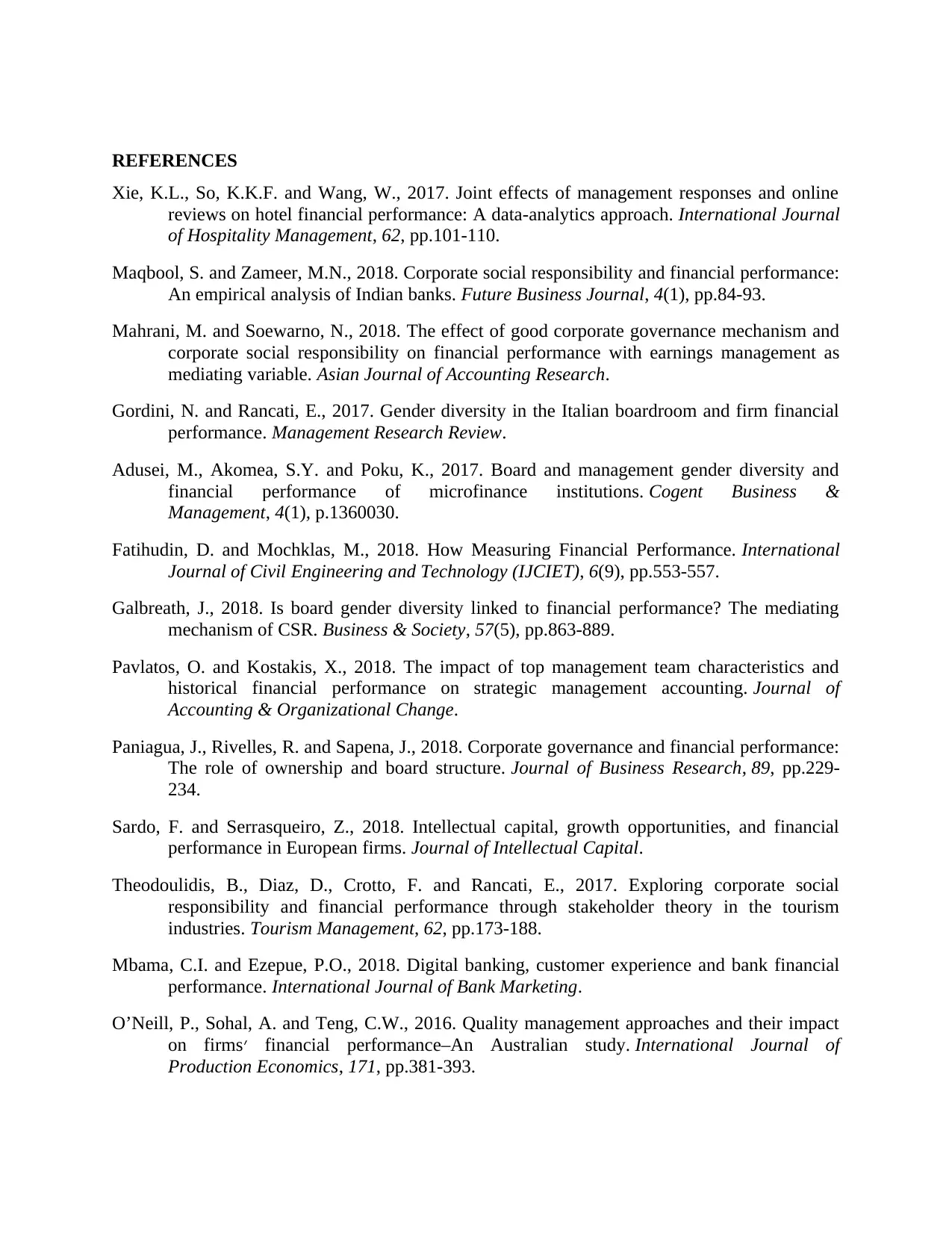
REFERENCES
Xie, K.L., So, K.K.F. and Wang, W., 2017. Joint effects of management responses and online
reviews on hotel financial performance: A data-analytics approach. International Journal
of Hospitality Management, 62, pp.101-110.
Maqbool, S. and Zameer, M.N., 2018. Corporate social responsibility and financial performance:
An empirical analysis of Indian banks. Future Business Journal, 4(1), pp.84-93.
Mahrani, M. and Soewarno, N., 2018. The effect of good corporate governance mechanism and
corporate social responsibility on financial performance with earnings management as
mediating variable. Asian Journal of Accounting Research.
Gordini, N. and Rancati, E., 2017. Gender diversity in the Italian boardroom and firm financial
performance. Management Research Review.
Adusei, M., Akomea, S.Y. and Poku, K., 2017. Board and management gender diversity and
financial performance of microfinance institutions. Cogent Business &
Management, 4(1), p.1360030.
Fatihudin, D. and Mochklas, M., 2018. How Measuring Financial Performance. International
Journal of Civil Engineering and Technology (IJCIET), 6(9), pp.553-557.
Galbreath, J., 2018. Is board gender diversity linked to financial performance? The mediating
mechanism of CSR. Business & Society, 57(5), pp.863-889.
Pavlatos, O. and Kostakis, X., 2018. The impact of top management team characteristics and
historical financial performance on strategic management accounting. Journal of
Accounting & Organizational Change.
Paniagua, J., Rivelles, R. and Sapena, J., 2018. Corporate governance and financial performance:
The role of ownership and board structure. Journal of Business Research, 89, pp.229-
234.
Sardo, F. and Serrasqueiro, Z., 2018. Intellectual capital, growth opportunities, and financial
performance in European firms. Journal of Intellectual Capital.
Theodoulidis, B., Diaz, D., Crotto, F. and Rancati, E., 2017. Exploring corporate social
responsibility and financial performance through stakeholder theory in the tourism
industries. Tourism Management, 62, pp.173-188.
Mbama, C.I. and Ezepue, P.O., 2018. Digital banking, customer experience and bank financial
performance. International Journal of Bank Marketing.
O’Neill, P., Sohal, A. and Teng, C.W., 2016. Quality management approaches and their impact
on firms׳ financial performance–An Australian study. International Journal of
Production Economics, 171, pp.381-393.
Xie, K.L., So, K.K.F. and Wang, W., 2017. Joint effects of management responses and online
reviews on hotel financial performance: A data-analytics approach. International Journal
of Hospitality Management, 62, pp.101-110.
Maqbool, S. and Zameer, M.N., 2018. Corporate social responsibility and financial performance:
An empirical analysis of Indian banks. Future Business Journal, 4(1), pp.84-93.
Mahrani, M. and Soewarno, N., 2018. The effect of good corporate governance mechanism and
corporate social responsibility on financial performance with earnings management as
mediating variable. Asian Journal of Accounting Research.
Gordini, N. and Rancati, E., 2017. Gender diversity in the Italian boardroom and firm financial
performance. Management Research Review.
Adusei, M., Akomea, S.Y. and Poku, K., 2017. Board and management gender diversity and
financial performance of microfinance institutions. Cogent Business &
Management, 4(1), p.1360030.
Fatihudin, D. and Mochklas, M., 2018. How Measuring Financial Performance. International
Journal of Civil Engineering and Technology (IJCIET), 6(9), pp.553-557.
Galbreath, J., 2018. Is board gender diversity linked to financial performance? The mediating
mechanism of CSR. Business & Society, 57(5), pp.863-889.
Pavlatos, O. and Kostakis, X., 2018. The impact of top management team characteristics and
historical financial performance on strategic management accounting. Journal of
Accounting & Organizational Change.
Paniagua, J., Rivelles, R. and Sapena, J., 2018. Corporate governance and financial performance:
The role of ownership and board structure. Journal of Business Research, 89, pp.229-
234.
Sardo, F. and Serrasqueiro, Z., 2018. Intellectual capital, growth opportunities, and financial
performance in European firms. Journal of Intellectual Capital.
Theodoulidis, B., Diaz, D., Crotto, F. and Rancati, E., 2017. Exploring corporate social
responsibility and financial performance through stakeholder theory in the tourism
industries. Tourism Management, 62, pp.173-188.
Mbama, C.I. and Ezepue, P.O., 2018. Digital banking, customer experience and bank financial
performance. International Journal of Bank Marketing.
O’Neill, P., Sohal, A. and Teng, C.W., 2016. Quality management approaches and their impact
on firms׳ financial performance–An Australian study. International Journal of
Production Economics, 171, pp.381-393.
⊘ This is a preview!⊘
Do you want full access?
Subscribe today to unlock all pages.

Trusted by 1+ million students worldwide
1 out of 13
Related Documents
Your All-in-One AI-Powered Toolkit for Academic Success.
+13062052269
info@desklib.com
Available 24*7 on WhatsApp / Email
![[object Object]](/_next/static/media/star-bottom.7253800d.svg)
Unlock your academic potential
Copyright © 2020–2025 A2Z Services. All Rights Reserved. Developed and managed by ZUCOL.





